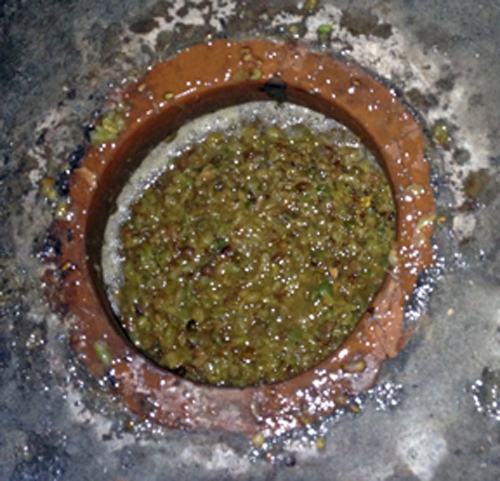
Rkatsiteli in qvevri with juice and chacha
Qvevri are earthen vessels crafted from clay, fired, coated on the inside with beeswax, often coated on the outside with cement and buried in the ground. Sizes range from one liter to thousands of liters. Compared to other winemaking vessels, qvevri are relatively inexpensive. For example, two qvevri craftsmen in Georgia charge about one dollar per liter. An oak barrel is 225 liters and if it is a French oak barrel can cost $1,000 or more. A 225 liter qvevri would cost $225 plus shipping.
Oak barrels are often used from three to five years. Qvevri are often used for hundreds of years. This ability to reuse a qvevri for centuries makes it the most economical vessel for making wine. We have visited winemakers that are still using qvevri crafted two centuries ago. We discovered that there are different winemaking protocols for making qvevri wine.
Some winemakers place whole grape clusters in the qvevri to ferment and age. The more popular practice is to press the grapes in a wood press using your feet. The grape juice and the chacha (skins, seeds and stems) are placed in the qvevri with the juice to ferment and age. Other winemakers use modern destemmer to destem the grapes and place the juice and chacha into the qvevri. Some producers add all the chacha to the qvevri while others add only a percentage of the chacha to the juice in a qvevri. Then there are a few producers that press the grapes and only add the juice to the qvevri.
Fermentation is done with the native yeasts. We asked if there were enough yeast to ferment the juice if only juice were added to a qvevri. The winemakers using this technique said the always had the juice ferment. After fermentation the techniques also vary. Some winemakers rack the wine into another qvevri without the chacha. While other winemakers seal the original qvevri letting the wine on its chacha. They usually let the wine on the chacha for six months. After which they may rack to another qvevri to help with clarification.
There isn’t one protocol that all winemakers making wine in qvevri follow. As a result, the wines will show different colors as well as aromas, tastes and tannins. A white wine made from only the juice in the qvevri will be a yellow color and probably floral and fruity with no tannins. A white wine fermented and aged on its chacha for six months will be an dark gold or amber color, have more intense aromas and tastes and have mild to bold tannins.
Consumers that want a qvevri made wine for a reason such as a white wine with bold tannins, need to know about the producer and the procedures the winemaker followed.
Cheers
Terry
© winemaking.winetrailtraveler.com






